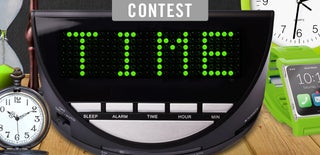Introduction: Toddler's Illustrated Clock
When my son was about 3 years old, we kept his daytime routine to a fairly predictable schedule, and he seemed to do well with a regular routine. Because he knew the routine well, he would often ask "is it time for snack/lunch/supper yet" and other such questions. He was also starting to understand the concept of time and the clock. To help him out, I made him a custom clock that he could use to keep tabs on his day. Keep reading to see how it was done.
Step 1: Choosing a Clock to Modify
For this project we'll be using a cheap off the shelf clock, and giving it a new clock face. You'll probably want to buy this in a physical retail store (as opposed to online), so you can get a good look at it, as there are a few things to look for:
- Plastic construction - We hung the clock down low at our son's eye level, so there shouldn't be any sharp metal or breakable glass that could be dangerous. Thus the frame and the clear front were all made from plastic.
- Assembled with screws - You'll need to take apart the clock frame and remove the hands. If the clock is assembled with screws, this is very easy to do. Look for screws on the back.
- Size of the clock face - If you plan on printing the clock face from your computer, you'll want to make sure the clock face is small enough to be covered by your printer's paper.
As a general rule, the cheaper you go, the more likely you'll find a clock that meets these criteria. I think I paid $3 for this one at my local Wal-Mart.
Step 2: Taking Things Apart...
Take it apart! Depending on your clock's design this may involve screwdrivers, locking tabs, etc. The main thing you'll need is access to the clock face, and the ability to remove the hands.
In most cheap clock mechanisms, the hands simply slide off the center post.
Save all the screws and hands in a safe place so they don't get lost or damaged, and so you can remember how they go back together.
Step 3: Making a New Clock Face
This is where your own creativity and knowledge of your child's schedule comes in. Think of the major events throughout your child's day and roughly when they occur. Luckily our son slept from about 7pm to 7am, so there wasn't much overlap on a normal 12-hour clock. Bedtime could be followed immediately by breakfast.
For my clock, I measured the size of the clock face and created a new one on the computer. I drew various icons (a bed for bedtime, etc), and scanned them in individually. I then placed the drawings around the clock in their proper positions. Once complete, this was printed out at 100% (actual) size to match the size of the actual clock face.
Of course, you could also do this by hand without much trouble, it's up to you.
Step 4: Putting It All Together
When your clock face is complete, cut out the outside circle, as well as a small circle in the middle for the center post to stick through.
I assumed this schedule would need updating in the future, so I just stuck it to the clock using small loops of blue painters tape, so it could be easily removed and replaced.
With the graphics in place, we only put the hour hand back on the clock. At his age, the minutes and seconds hands were too confusing. Having just the hour hand was perfect, as there was only one arrow pointing to the current time & activity.
With the clock re-assembled, we hung it on the wall down at our son's eye level in our kitchen so he could check it anytime he wanted to. Whenever he wanted to know if it was time for this or that, we could consult the clock together and talk about what he had already done, what was coming up, and work on teaching and reinforcing concepts of time & schedule with him on a regular basis. Overall he really enjoyed having a clock made just for him.

Runner Up in the
Time Contest













